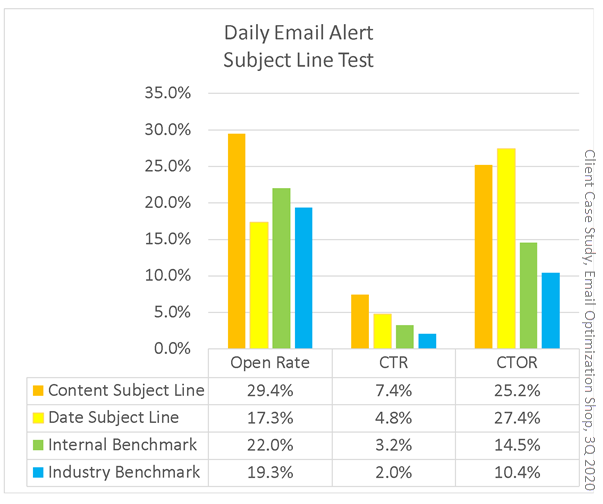 Lots of email marketers test subject lines, but the key to long-term success is testing formulas rather than specific copy.
Lots of email marketers test subject lines, but the key to long-term success is testing formulas rather than specific copy.
In this case study, the winning subject line formula generated an open rate lift of 70% and a lift of 56% in click-through rate. Best of all, because we tested formulas instead of copy, they’ll be able to roll this out to all future daily email alerts.
And since their business goal is visitors to the site, not leads, orders, or revenue, this increase in unique click-through rate goes directly to their bottom-line goal.
Let’s start with the data.

This is a daily email alert, dynamically customized with content based on choices presented to subscribers in a preference center. It’s an automated email, sent each day without manual intervention. This is a very resource-efficient way to deliver relevant content on a frequent basis.
We decided to test subject lines to see if we could boost performance. In addition to knowing that formulas are the best way to test into subject lines that will deliver consistently better results for the future, we needed to use formulas so that they could be dynamically generated for each send.
For the content subject line formula, we took the title of the lead article in each issue of the alert. With this formula, the actual copy that appears in the subject line changes not just with each send, but also potentially for each recipient, since the dynamic nature of the content creates a customized alert for each person, based on their preferences. That said, the formula — first article title — remains the same.
Here are some examples:

For the date subject line, we used ‘Your <day of week> news from <brand>’ where the first field would be Monday, Tuesday, Wednesday, Thursday or Friday (they only send on weekdays), and the brand was consistently the organization’s name.
Here are some examples:

This A/B split testing took place on every send of the daily alert, through all of 3Q 2020; we wanted to get a definitive read on the effectiveness of both subject line options. This particular send was the best example of the lift we saw from our test. While this is the best case scenario, the content subject line consistently beat the date subject line.
It’s nice to talk about 70% lifts in open rates and 56% lifts in click-through rates, as we see in this test. But usually these are diagnostic metrics, not business metrics, and they should not be used as key performance indicators (KPIs).
But in this case, the business goal is to drive as many individual people, or visitors, to the website as possible. As such, the unique click-through rate, which is what we are measuring here, functions as their KPI, or their business metric.
As you can see, the content subject line for this issue of the daily alert bested not only the date subject line test, but also the internal and industry benchmarks.
This isn’t the first time I’ve tested subject line formulas like this. Whenever I’ve put a date subject line up against a subject line with copy that changes based on the content of the email newsletter, the latter wins.
If your newsletter has a data or other relatively static subject like that doesn’t highlight the unique content in each issue, try this type of A/B split test to see if you can boost not just opens but also clicks and whatever your business metric, or KPI, is.
Let me know how it goes!






